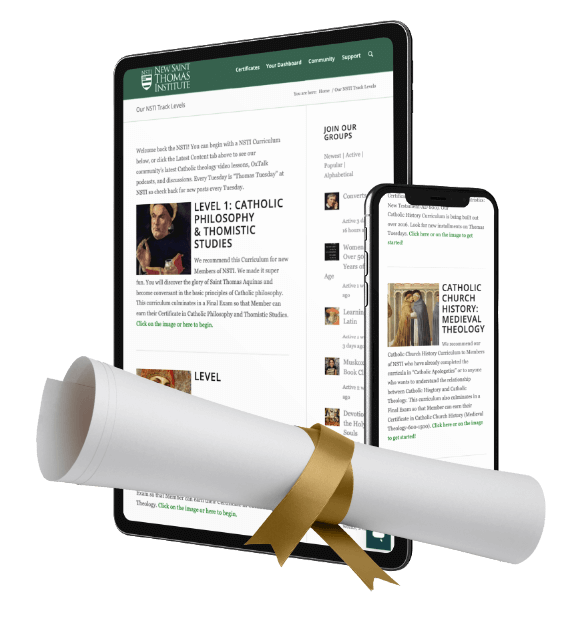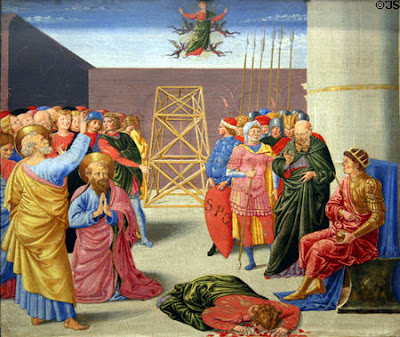Simon Magus vs. Simon Peter in Rome
From Taylor Marshall’s New Book The Eternal City – Rome and the Origins of Catholic Christianity (due December 2012):
Catholic tradition relates that Saint Peter’s ministry in Rome was challenged by an evil antagonist named Simon Magus or Simon the Magician.
Simon Magus was a magician of Samaria who had seduced the people of that region. According to the ninth chapter of Acts, Simon Magus proclaimed that he was someone great and the Samaritans said, “This man is the power of God, which is called great” (Acts 9:10).
Yet when Saint Philip came to the region of Samaria preaching the Gospel of Jesus Christ, Simon Magus and all the people converted and received baptism. Simon Magus, then, became a Christian. Saint Peter and Saint John then visited the region to meet these new Christians and administer the sacrament of Confirmation to them. Simon himself received Confirmation and the Holy Spirit.
And when Simon saw that, by the imposition of the hands of the Apostles, the Holy Ghost was given, he offered them money, Saying: Give me also this power, that on whomsoever I shall lay my hands, he may receive the Holy Ghost.
But Peter said to him: Keep thy money to thyself, to perish with thee: because thou hast thought that the gift of God may be purchased with money. Thou hast no part nor lot in this matter. For thy heart is not right in the sight of God. Do penance therefore for this thy wickedness: and pray to God, that perhaps this thought of thy heart may be forgiven thee. For I see thou art in the gall of bitterness and in the bonds of iniquity.
Then Simon answering, said: Pray you for me to the Lord that none of these things which you have spoken may come upon me.” (Acts 8:18–24).
Sacred Scripture does not record what became of Simon Magus. Simon Magus’ attempt to purchase the office of Apostle is certainly noteworthy. Clearly, Simon envied the power of the Apostles and his conversion was short lived. Catholic theology has ever since referred to the sin of Simony as the attempt to purchase ordination or church appointments with money. By extension, the buying and selling of anything holy and sacred is called Simony.
Saint Justin Martyr of the second century records the odd claims and actions of Simon Magus. According to Saoint Justin, Simon Magus claimed to be God. Following Saint Peter, Simon Magus came to Rome during the reign of the Emperor Claudius. As Saint Peter built the Catholic Church in Rome, Simon Magus created his parallel anti-church.
A statue of Simon Magus was eventually erected on the island in the Tiber River with the inscription, Simoni Deo Sancto meaning “to Simon the Holy God.” Some scholars debate this point, claiming that Saint Justin confused a statue dedicated to the Sabine divinity Semo Sancus with that of the historical Simon the Magician. Semo Sancus is an ancient Sabine deity for oaths, contracts, law, matrimony, and legal fidelity. In 1574, an altar dedicated to Semo Sancus was discovered on the island of the Tiber River with the following inscription Semoni Sanco Deo, which translates as “to Semon the Holy God.” This discovery led to the belief that Saint Justin had made an observational mistake concerning what he thought was the idol of “Simon the Holy God” on the Tiber River.
There is a problem with this theory in that it assumes that the deity’s name is Semo. In Latin, semo or the plural semones derives from semi-homines or semi-humans. These are the dii medioxumi who were lower-level deities. The semones are the demigods of the Roman pagan pantheon. According to Marcus Porcius Cato, a Sanco is a spirit {daimon} and not a god {theos}.
From the point of view of Roman paganism, it does not make sense to use a generic noun of semo for a demigod and then also the noun deus for a god. It would be like saying, “to the demigod holy god.” What is far more likely is that the Simon Magus, as a magician and adapter of local paganism, co-opted the Roman tradition of a semi-human god of law and covenant and identified himself as the semi-human god. This would conform to the description of Simon Magus in Acts 8:10 as being “this man who is the power of God.” So then, it was not Justin Martyr who was confused, but rather Simon Magus who confused his identity with the semi-human god of Rome.
Saint Justin relates that Simon Magus traveled with a prostitute from Tyre named Helena. Simon claimed that she was the first thought of God whom he, as the “great power of God,” had freed from bondage. Here again we find Simon assimilating ancient myths and names into his mystical theology.
Tradition identifies Simon Magus as the first Christian heretic, the first Gnostic, and the founder of the sect of the Simonians. Simon Magus had a corpus of Scripture. Saint Hippolytus refers to a Simonian text entitled The Great Declaration and we also know treatises named The Four Quarters of the World and Sermons of the Refuter.
Simon Magus claimed that he appeared as God the Father to the Samaritans, as God the Son to the Jews, and as God the Holy Ghost to the Gentiles. According to Simon Magus, God’s first thought was female and created the angels. That feminine thought was betrayed by the angels and imprisoned in the world. She reincarnated several times, once as Helen of Troy but finally into Simon’s girlfriend Helena of Tyre who had been a slave and prostitute. God then descended in the form of Simon Magus to rescue this feminine first thought (Helena the prostitute) and confer salvation on mankind. Simon Magus only appeared human so as to fool the evil angels that had imprisoned his girlfriend Helena. He claimed to have suffered under the Jews in Judaea, a claim that indicates his belief that he was Jesus Christ at some point. At the center of Simon’s theology is the belief that God issued forth a feminine principle of wisdom named Sophia that became trapped within creation. God then descends so as to liberate this feminine principle of wisdom. Simon Magus conveniently revealed himself and his profligate girlfriend as God and the feminine principle. When speaking to Greeks, Simon referred to himself as Zeus and Helena as Athena, the goddess of wisdom.
According to the apocryphal Acts of Peter and Paul a formal debate was scheduled at which Simon Magus would debate Saints Peter and Paul before the Emperor Nero. Simon Magus tells Nero to have a lofty tower of wood erected on which Simon Magus will ascend. Then, the angels of Simon Magus will carry him throughout the air. By this miracle, says Simon Magus, he will prove that his words are true and the Gospel of Peter and Paul is false. Nero complies and the tower is built.
The next day, many gather to see this spectacle. Paul shows deference to Peter as Pope saying, “It is my part to bend the knee, and to pray to God and thine to produce the effect, if thou shouldst see him attempting anything, because thou wast first taken in hand by the Lord.” Paul then kneels in prayer.
Simon Magus then ascended the wooden tower crowned with a laurel, stretched out his hands and began to fly to the astonishment of all. Nero immediately proclaimed to Peter, “Simon is true, but you and Paul are liars!”
Then Peter, looking steadfastly upon Paul, said: Paul, look up and see. And Paul, having looked up, full of tears, and seeing Simon flying, said: Peter, why art thou idle? Finish what thou hast begun; for already our Lord Jesus Christ is calling us. And Nero hearing them, smiled a little, and said: These men see themselves worsted already, and are gone mad. Peter said: Now thou shalt know that we are not mad. Paul said to Peter: Do at once what thou doest.
And Peter, looking steadfastly against Simon, said: I adjure you, ye angels of Satan, who are carrying him into the air, to deceive the hearts of the unbelievers, by the God that created all things, and by Jesus Christ, whom on the third day He raised from the dead, no longer from this hour to keep him up, but to let him go. And immediately, being let go, he fell into a place called Sacra Via, that is, Holy Way, and was divided into four parts, having perished by an evil fate.
Nero waits three days to see of Simon Magus will return to life. The magician, of course, does not rise again from the dead. In consequence, Peter and Paul fall foul of Nero. The two Apostles then receive their glorious martyrdoms.
These apocryphal stories cannot be relied upon with historical certainty. However this document and others do depict a final standoff between Saint Peter and Simon Magus in Rome. For example, Saint Cyril of Jerusalem writing near A.D. 346 records Simon Magus pretended to fly but was really drawn about in the air by demons. According to Cyril, when Peter and Paul knelt down and prayed, their prayers brought Simon to earth as a mangled corpse. A similar account is found in the apocryphal Acts of Peter from the second century. However Simon’s fall from the air leaves him only with a broken leg in that account. Simon, in this version, subsequently dies of surgical malpractice.
While the historical facts of the Acts of Peter cannot be verified, the earliest sources do confirm that Saint Peter was sentenced to death by crucifixion by the Emperor Nero. In the next chapter, we will investigate the most recent archeological evidence regarding the excavation of Saint Peter’s skeleton beneath the Vatican. Sciences and Tradition converge with Scripture. Christ built His Catholic Church quite literally on Peter.
Stayed tuned for the release date of the new book: The Eternal City – Rome and the Origins of Catholic Christianity.
Do you enjoy reading Canterbury Tales by Taylor Marshall? Make it easier to receive daily posts. It’s free. Please click here to sign up by Feed or here to sign up by Email. Please also explore Taylor’s books about Catholicism at amazon.com.
What to Watch Next
Thomas Jefferson shoehorned “the wall of separation of church and state” into modern politics. It’s time to...
Christian Nationalism or Christian Patriotism? by Dr. Taylor Marshall Many Conservatives in the post-MAGA world are advocating...
Bishop Strickland criticized Father James Martin in public, since no other bishop (including Martin’s ordinary) would chastise...
SHOP THE TAYLOR MARSHALL STORE
Dive Deeper

GET CONFIDENT IN YOUR FAITH
Explore the fascinating world of Catholic teachings with Dr. Marshall. Together you’ll unpack the brilliant answers the Church gives to tough questions about the Faith. The best part: you go at your own pace. Start this exciting journey today.


 >
>



